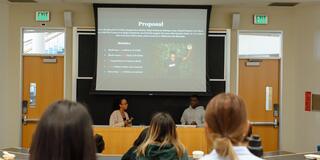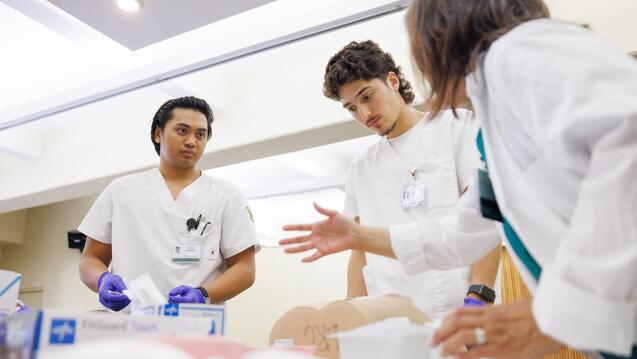United We Stand

Can a photograph stop a bullet? Can a song curb bigotry?
In the Honors College course called Gun Violence, Music, and Youth, students dig into questions about the role of art in addressing social problems. Taught by Erin Grinshteyn, assistant professor of public health, and Byron Au Yong, assistant professor of music, the class aims to educate students about gun violence while also giving them creative tools to prevent it.
Next spring, five students from the class will present their coursework on campus at Creative Activity and Research Day. Sophomore psychology major Isabella Dickson will present on the impact of police-related gun deaths in black communities. Junior politics major Mark Gravador will speak on legislation for safe gun storage.
Tag-Team Teaching
In Gun Violence, Music, and Youth, the professors take turns teaching. Grinshteyn draws on her research on fear and violence to give students context and hard numbers. For example: the gun homicide rate in the U.S. is 25 times higher than in other high-income countries.
Meanwhile, Au Yong, a composer, shows students how artists — both musicians and others — are responding to the crisis. His interactive musical, Trigger, a.k.a. (Be)longing, was a response to the shootings at Virginia Tech, Sandy Hook, and other schools. Au Yong also introduces students to artist JR, who worked with Time magazine to create “Guns in America,” a multimedia web-based collage focusing on the gun debate. The collage was then recreated in mural form and displayed in museums across the country.
Young People Lead
“The topic of gun violence is so relevant,” says Dickson, who was drawn to the class by its name. “A lot of movements to stop gun violence are being led by people my age.”
Dickson created a digital project, “Bella’s Life Matters,” that includes statistics on police-related gun deaths in black communities and invites visitors to share their personal stories.
“I have spaces where people can journal, talk about police brutality and how it’s affected them,” she says.
Gravador’s project is a campaign concept of t-shirts, stickers, and posters promoting legislation for safe gun storage, to limit access to unauthorized users and children. He says that the artistic nature of the class helped him see the legislation and policy he’d been studying in his politics courses from a new perspective.
“When you’re just super focused on the straight-up law or policy, you sometimes forget to step back and ask yourself how to promote your cause in a humanistic way,” says Gravador, who is a legal studies minor.
Honors College Collaboration
For Grinshteyn and Au Yong, last spring was their first time co-teaching a class with a USF professor from another discipline. They created the course because the new Honors College is encouraging such collaborations.
“The university understands that getting professors together to work on the same problem from unique perspectives is going to widen the ability to address any particular issue,” says Grinshteyn. “Before teaching this class, I saw art purely from the perspective of enjoyment. Now I see it as a way to communicate about problems with the masses in a way that my writing scientific pieces in academic journals isn’t necessarily doing.”
“The data that Erin presents has helped me, too,” Au Yong says. “What I’ve been doing has been so qualitative — honoring the emotions and experiences of people who have been through tragedy. The numbers tell their own story.”


